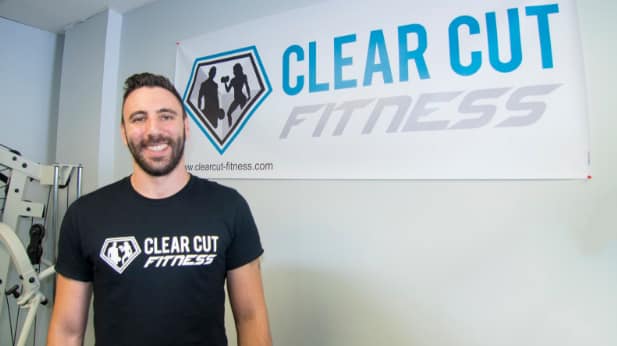Low Back Pain, Part 2: Why Core Training Counts
September 20, 2016
Guest Post By Chris Diamantakos
My recent post on “Low Back Pain Stretches: The Good, The Bad, and The Ugly“ struck a chord. The article focused on how some back pain stretches could actually make things worse. It went on to offer alternatives.
But that’s only part of the puzzle. Equally important: core training, the subject of this post.
Specific core training is one of the key components to rehabbing your low back injury, preventing future injuries, and optimizing your strength in the weight room. The core works hand in hand with the back muscles to support the spine. If the core isn’t strong enough, low back injury could result.
We’re talking about everything from low back injuries from herniated discs to spondylolisthesis to bone damage to fractures. Hence the need to get the core working properly.
Here’s how we break it down:
- Breathwork
- Core Activation and Muscular Endurance
- Awareness and Stability
- Avoid Shitty Core Exercises
Important: Always consult a physician before beginning a rehab program. Low back pain can have many causes. Remember: Dr. Google is not a real doctor. Never self-diagnose!
Breathwork
Self-proclaimed manly men may find the idea ridiculous, but breathwork is crucially important to strength, mobility, and low back pain. Focus on using the right muscles to develop big, strong and efficient breathing patterns.
Many people develop anxious and inefficient “chest breathing” habits. Shortness of breath results.
But there’s a better way.
Take deep breaths.
Your chest shouldn’t be the only thing rising and lowering. You want your diaphragm (the big muscle underneath your ribcage) to expand and allow your lungs to fill with oxygen. This provides the body with an efficient oxygen supply. It also allows you to create something called “intra-abdominal pressure.” It can even calm your nerves.
Intra-abdominal pressure is a fancy term for creating stability with your core and your body’s ability to create and maintain pressure around the spine/abdominal area.
The stronger the core, the heavier you can safely lift. If your core is weak and instar-abdominal pressure is low….
… good luck increasing those lifts or creating maximum power output during sports.
Your goal is to breath correctly to create the intra-abdominal pressure that protects your spine. Your spine will be strong and supported. It won’t look like one of those flimsy, waving inflatable tube men you see outside of the car dealership.
Here is a great beginner exercise for rehabbing your low back: Croc Breathing
- Lie on your stomach, put your head in your hands, try not to kiss the floor, and take big deep breaths which will expand your diaphragm. You’ll notice your body will rise and lower significantly. If you can’t feel anything happening, get your training partner to put his/her hands on the side of your obliques. They should feel your obliques expanding outwards. Each rep usually gets bigger and stronger. I like to do these for 2-3 sets of 6-8 reps in the warm-up.
- Progression: Half Kneeling Breathing
Core Activation and Muscular Endurance
Poor movement patterns can lead to injury. If your core isn’t firing properly, or at the right times, you can compromise the stability of your trunk, leading to injury when training.
Dr. Stuart McGill found that activation and muscular endurance is more suitable for the rehab process than muscular strength.
Dr. McGill also says that bouts of isometric endurance should last around 8 seconds. That’s right guys, time to say goodbye to your 5 minute planks. If you’re going to plank, try intervals of 10s work: 10s rest for sets. (There are many reasons for this but one of the biggest is because short relaxation of the muscles provides more oxygen helping the blood flow to the area.)
While every torso muscle contributes to spinal stability the abdominal muscles, obliques and QL are most important (McGill, S (2007) Low Back Disorders).
Get these muscles firing properly to stabilize your spine. You’ll support your spine and may relieve pressure from the nerve that’s causing your pain. Focus instead on exercises and lifts that produce less spinal stress or compression. Light deadlifts are fine, along with goblet/front squats and many upper body exercises. These core activation techniques should also be used in your warm-up even after your back is healthy again. You’ll prepare your body for the heavy weights to come with these exercises.
Deadbugs
One of the best activation exercises out there is the dead bug. I put a little twist on it and use a stability ball between my arms and legs. This forces you to use your core so you don’t compensate with other muscles. This works your whole abdominal region.
Side Plank (or Side Bridge)
These target your obliques and are an isometric exercise. We’ll be performing these for sets of about 8 seconds. I’ve personally found that working up to 10 seconds is acceptable and beneficial.
You want to make sure you’re contracting your glutes and your core while maintaining a straight posture.
McGill Curl Ups
These are my favourite (or, favorite for Eric’s American brethren). This exercise sets your hips and spine in a proper position. It’s similar to a sit-up without all the terrible spinal flexion and disc compression. After just a few reps you really start to feel the burn. Try these out for 6-8 reps with a 2-second isometric hold at the top, slow, controlled tempo.
Awareness and Stability
Unfortunately, it usually takes an injury for people to pay attention to how they move. The way you walk, sit, stand, slouch, or run all play a role in your body’s health and posture. It’s common to see people with low back pain walk around with either a big lordotic curve (stripper butt) or a big kyphotic curve (Neanderthal).
Even when performing everyday tasks, you should be aware of your posture and movement patterns. For example: when you bend over to pick something up from the ground, try to keep your core and glutes tight, neutral spine position and bent with your legs and arms.
Practice awareness and stability while exercising. You’ll want to become familiar with “locking your rib cage onto the pelvis” also known as “abdominal bracing”. This is how you create stiffness; a key component to maximizing strength and power in the gym. Pretend someone is going to punch you in the stomach hard, flex your abs, and create stiffness.
Avoid Shitty Core Exercises
This isn’t just because we’re looking for the most effective exercises. We want to avoid shitty exercises that can actually make things worse, reverse the rehab process or even produce further injury.
Two of the most commonly used core exercises are the sit up and the superman. Both of these, put tremendous amounts of pressure on the spine, use poor posture, and can increase your chance of injury.
Sit Up. This exercise is probably the most widely known core exercise in history. You see it in every gym, and every movie that showcases a gym. Evidence from Stu McGill shows that sit ups have a very high compressive load on the low back, enough to make an existing injury worse, or cause enough repeated flexion that you’ll be susceptible to a low back injury (1). This is because you’re flexing the spine under a load, instead of having a neutral spine with load. When the spine is flexed under load your discs become vulnerable to injury.
The Superman. Sure, it looks cool, but this exercise shouldn’t be part of any exercise program. There are plenty other exercises that work your lower back and spinal erectors in a much safer and effective way. Any deadlift variation does the trick. In the words of McGill “This results in over 6000 N of compression to a hyperextended spine… It is a poorly designed exercise”(1). Don’t forget that we’re looking to perform exercises in a neutral spine, not hyperextended.
If you suffer from low back pain, the last thing you want to do is make it worse. Avoid the Sit ups and Superman, and incorporate exercises that train the core in a neutral spine.
The Takeaway
Specific core training is one of the most important parts of the rehab process of low back pain. Take the breath work, core activation and awareness seriously. You’ll be on your way to a back that moves the way it should before you know it.
ABOUT THE AUTHOR
Chris Diamantakos is a personal trainer, nutrition coach and owner of Clear Cut Fitness in Toronto, Canada. He works on low back pain issues with anyone from postpartum women to NHL athletes. His personal website is www.chrisdiamantakos.com
References
1. McGill, S (2007) Low Back Disorders
2. McGill, S (2014) Ultimate Back and Fitness Performance
3. Kell, R. T., & Asmundson, G. J. (2009). A comparison of two forms of periodized exercise rehabilitation programs in the management of chronic nonspecific low-back pain. The Journal of Strength & Conditioning Research,23(2), 513-523.
4. McGill, Stuart M., Aaron Childs, and Craig Liebenson. “Endurance times for low back stabilization exercises: clinical targets for testing and training from a normal database.” Archives of physical medicine and rehabilitation 80.8 (1999): 941-944.









